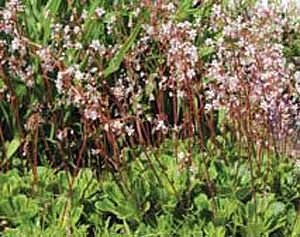
Garden news
May is a time for lush green growth and blasts of late spring / early summer colour. It’s a time for newly planted plants to get established before the heat of the summer, soaking up all that lovely moisture still in the ground. There is lots to do and lots to see in the garden and as the weather warms up lots more opportunities for you to get out in the garden and enjoy that some time outside.Plant of the Month: Saxifraga x urbium London Pride
Saxifraga is an incredibly large and diverse genus, encompassing around 480 species of alpine or woodland plants. They are generally small, made up of rosettes of green leaves and vary in habit from compact cushions to plants that become wide-spreading mats or tall and leafy-stemmed. They produce flowers in spring and early summer.
Saxifraga is the largest genus in the family Saxifragaceae, commonly known as saxifrages or rockfoils. The Latin word saxifraga means literally "stone-breaker", from Latin saxum ("rock" or "stone") and frangere ("to break"). It is actually thought to indicate a medicinal use for treatment of kidney stones, rather than breaking rocks apart!
Due to the huge number of species, Saxifraga have been classified into many sections, all of which have produced a range of attractive cultivars and readily hybridise with each other. They are found in the temperate and sub-arctic zones of the northern hemispheres, with some "exotic" outposts in Ethiopia, Mexico and the Arctic region. Several subalpine species from dryish spots in mountainous regions have succulent, usually nicely glaucous leaves in dense rosettes and make very dense, floriferous clusters with time. Most Saxifrage are best grown in small crevices filled with well-drained soil in full sun to part shade, however a few of the bigger ones can tolerate a lot of moisture.
Saxifraga x urbium is a garden-made hybrid between S. umbrosa and S. spathularis. The popular London Pride has been known in cultivation since the 1700s.. It is commonly grown and is perhaps the easiest to grow of all the cultivars. The plants form a low clump of leathery leaves, arranged in rosettes, spreading slowly to form a thick mat. The Foliage is dark green with interesting golden-yellow leopard-spots. Stems of pale-pink flowers appear in late spring.
It is one of the best all-purpose edging plants for moist, shady areas, and deserving much wider use in gardens. It has 'cabbagey' rosettes of evergreen, leathery, spoon-shaped leaves and white flowers, spotted with red. The clumps are easily divided in early spring or late summer. They will tolerate heavy shade but do not like to be smothered by fallen leaves in the autumn / winter.
This particular Saxifraga prefer a moist, semi-shaded site as they need protection from the hot midday sun. Even when they are not flowering, saxifrages are neat plants which make them great little “edgers”. For this reason, I often plant them at the front of an order in a slightly shaded location. I find they combine well with the grassy leaves of Liriope Muscurii and look great if planted in front of aquilegia and the unfurling fronds of ferns. Make the most of this little plant, it can often be planted in a shady corner of the garden and light up that bit of border you have ignored for far too long.
Jobs to be doing this month include:
Ornamental Garden:
• This month is a fast period of growth. Late frosts may catch early blooms and soft growth – remove any damaged growth.
• Spray roses with rose clear or similar.
• Weed
• Continue to remove spent flowers of spring bulbs but not the foliage until it has withered and yellowed.
• Chelsea-chop time – If the Nepeta and Sedums are looking leggy then cutback by a third to encourage compact growth that will not collapse later in the season. This can be applied to the lavender, echinops, Echinacea, aster, helenium and salvia too if felt necessary.
• Trim Rosemary, Thyme and Sage if not done in April.
• Cutback withered daffodil or tulip stems once they have turned yellow.
• Trim grass edges of borders regularly to keep neat and tidy.
• Prune spring flowering clematis
• Stake and support herbaceous perennials if necessary
• If daffs gave a poor show lift and divide bulbs and replant.
• Continue deadheading spring bulbs.
• Start hardening off tender plants for planting out.
Vegetable Garden:
• Harvest Asparagus
• Direct sow french beans and sweet corn if weather is warm enough
• Start earthing up potatoes
• Harvest early crops such as radish / lettuce etc.
• Refrain from planting tomatoes too early as they suffer if exposed to temperatures below 12 degrees.
• Sow pumpkins, cucumbers, courgettes, squashes under cover now and outdoors towards the end of the month.

